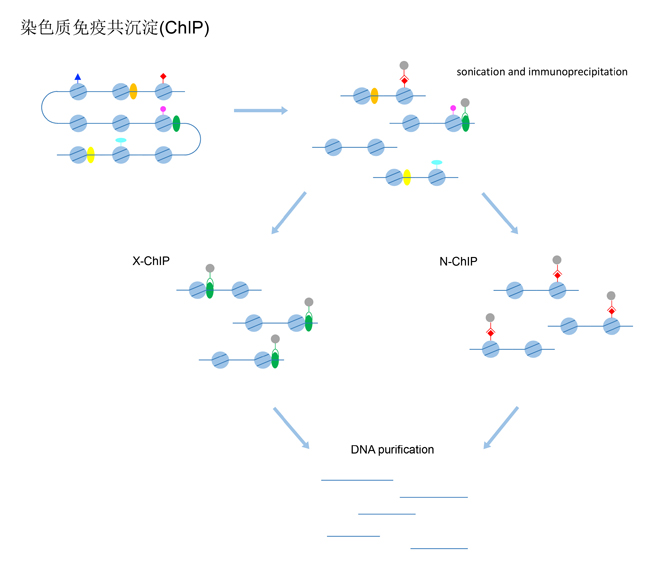

染色质免疫共沉淀实验方法
收稿日期: 2020-05-08
录用日期: 2020-08-13
网络出版日期: 2020-08-26
基金资助
国家自然科学基金(31861130355)
Protocols for Chromatin Immunoprecipitation
Received date: 2020-05-08
Accepted date: 2020-08-13
Online published: 2020-08-26
染色质免疫共沉淀(ChIP)技术是一种检测蛋白质与DNA结合的实验技术。该方法可以先进行样品交联, 然后将蛋白质与DNA复合物进行随机DNA切断, 再借助免疫学方法特异性富集与目的蛋白相结合的DNA片段, 从而检测转录因子等目的蛋白质与DNA的结合情况, 鉴定基因启动子或其它DNA结合位点。该方法同时也可应用于研究基因组特定位点的组蛋白修饰情况。该文介绍了依赖交联固定的常规免疫共沉淀(X-ChIP), 以及适用于103细胞级别微量实验材料的基于微球菌核酸酶非交联免疫共沉淀(ULI-NChIP)具体操作过程和注意事项。

关键词: 染色质免疫共沉淀; 基于微球菌核酸酶非交联免疫共沉淀
王泓力 , 焦雨铃 . 染色质免疫共沉淀实验方法[J]. 植物学报, 2020 , 55(4) : 475 -480 . DOI: 10.11983/CBB20076
Chromatin immunoprecipitation (ChIP) is a teschnique used to investigate protein-DNA interaction. Briefly, protein and associated DNA are crosslinked, which is optional. Then the DNA-protein complexes are fragmented. By using an appropriate antibody, cross-linked DNA fragments associated with the protein of interest are selectively immunoprecipitated. ChIP is commonly used to identify binding regions of DNA-binding proteins, such as transcription factors. ChIP is also used to analyze histone modification profiles in combination with antibodies against specific histone modifications. Here we describe protocols and related tips for cross-linked ChIP and ultra-low-input micrococcal nuclease-based native ChIP (ULI-NChIP), which can be applied to rare cell populations at the 103 cell level.

| [1] | Adli M, Zhu J, Bernstein BE (2010). Genome-wide chromatin maps derived from limited numbers of hematopoietic progenitors. Nat Methods 7, 615-618. |
| [2] | Barski A, Cuddapah S, Cui K, Roh TY, Schones DE, Wang Z, Wei G, Chepelev I, Zhao K (2007). High-resolution profiling of histone methylations in the human genome. Cell 129, 823-837. |
| [3] | Brind’Amour J, Liu S, Hudson M, Chen C, Karimi MM, Lorincz MC (2015). An ultra-low-input native ChIP-seq protocol for genome-wide profiling of rare cell populations. Nat Commun 6, 6033. |
| [4] | Collas P (2010). The current state of chromatin immunoprecipitation. Mol Biotechnol 45, 87-100. |
| [5] | Das PM, Ramachandran K, van Wert J, Singal R (2004). Chromatin immunoprecipitation assay. Biotechniques 37, 961-969. |
| [6] | Hitchler MJ, Rice JC (2011). Genome-wide epigenetic analysis of human pluripotent stem cells by ChIP and ChIP-Seq. In: Schwartz PH, Wesselschmidt RL, eds. Human Pluripotent Stem Cells: Methods and Protocols. New York: Humana Press. pp. 253-267. |
| [7] | Jackson V (1978). Studies on histone organization in the nucleosome using formaldehyde as a reversible cross- linking agent. Cell 15, 945-954. |
| [8] | Johnson KD, Bresnick EH (2002). Dissecting long-range transcriptional mechanisms by chromatin immunoprecipitation. Methods 26, 27-36. |
| [9] | Mikkelsen TS, Ku M, Jaffe DB, Issac B, Lieberman E, Giannoukos G, Alvarez P, Brockman W, Kim TK, Koche RP, Lee W, Mendenhall E, O’Donovan A, Presser A, Russ C, Xie X, Meissner A, Wernig W, Jaenisch R, Nusbaum C, Lander ES, Bernstein BE (2007). Genome-wide maps of chromatin state in pluripotent and lineage-committed cells. Nature 448, 553-560. |
| [10] | O'Neill LP, Turner BM (2003). Immunoprecipitation of native chromatin: NChIP. Methods 31, 76-82. |
| [11] | Orlando V (2000). Mapping chromosomal proteins in vivo by formaldehyde-crosslinked-chromatin immunoprecipitation. Trends Biochem Sci 25, 99-104. |
| [12] | Orlando V, Strutt H, Paro R (1997). Analysis of chromatin structure by in vivo formaldehyde cross-linking. Methods 11, 205-214. |
| [13] | Singal R, van Wert JM, Ferdinand L Jr (2002). Methylation of alpha-type embryonic globin gene alpha pi represses transcription in primary erythroid cells. Blood 100, 4217-4222. |
| [14] | Spencer VA, Sun JM, Li L, Davie JR (2003). Chromatin immunoprecipitation: a tool for studying histone acetylation and transcription factor binding. Methods 31, 67-75. |
| [15] | Thorne AW, Myers FA, Hebbes TR (2004). Native chromatin immunoprecipitation. In: Tollefsbol TO, ed. Epigenetics Protocols. New York: Humana Press. pp. 21-44. |
| [16] | Wang J, Tian C, Zhang C, Shi B, Cao X, Zhang TQ, Zhao Z, Wang JW, Jiao Y (2017). Cytokinin signaling activates WUSCHEL expression during axillary meristem initiation. Plant Cell 29, 1373-1387. |
| [17] | Weinmann AS, Bartley SM, Zhang T, Zhang MQ, Farnham PJ (2001). Use of chromatin immunoprecipitation to clone novel E2F target promoters. Mol Cell Biol 21, 6820-6832. |
| [18] | Wells J, Farnham PJ (2002). Characterizing transcription factor binding sites using formaldehyde crosslinking and immunoprecipitation. Methods 26, 48-56. |
/
| 〈 |
|
〉 |